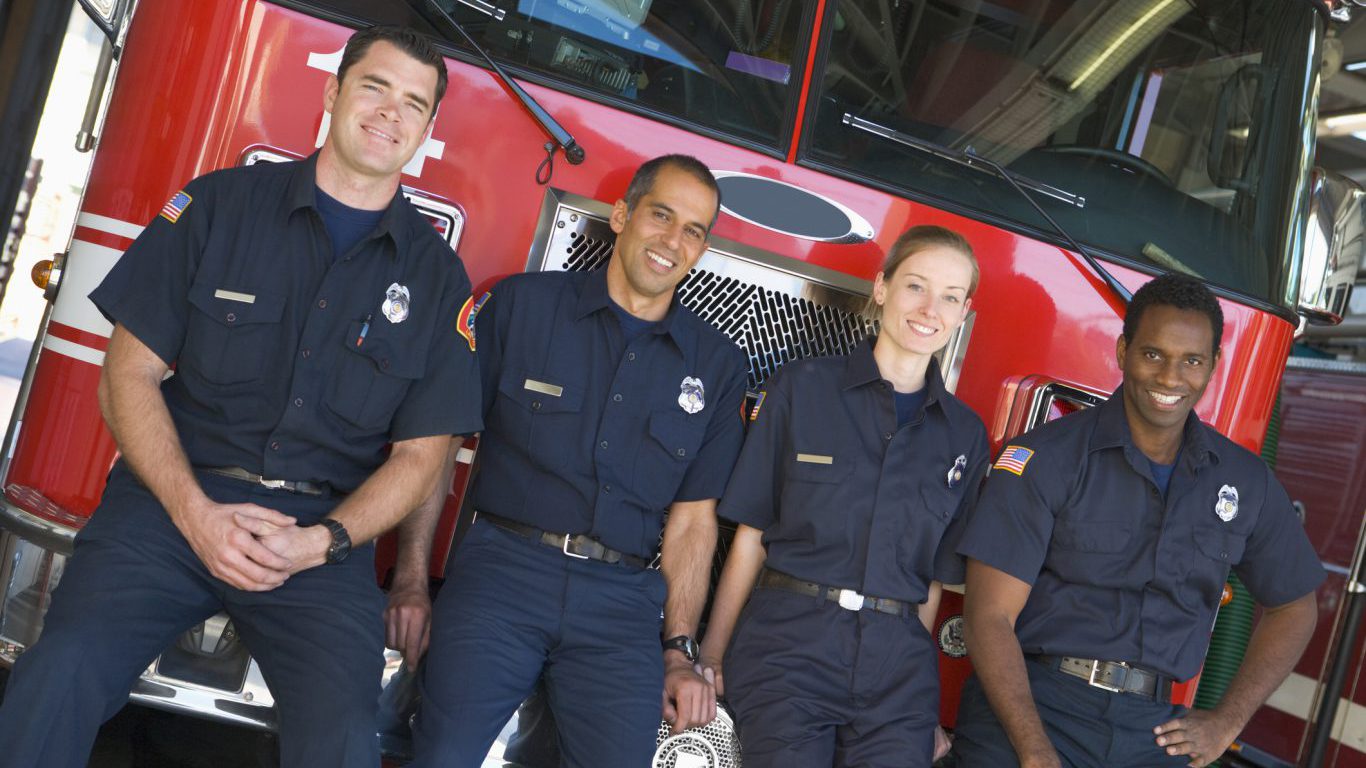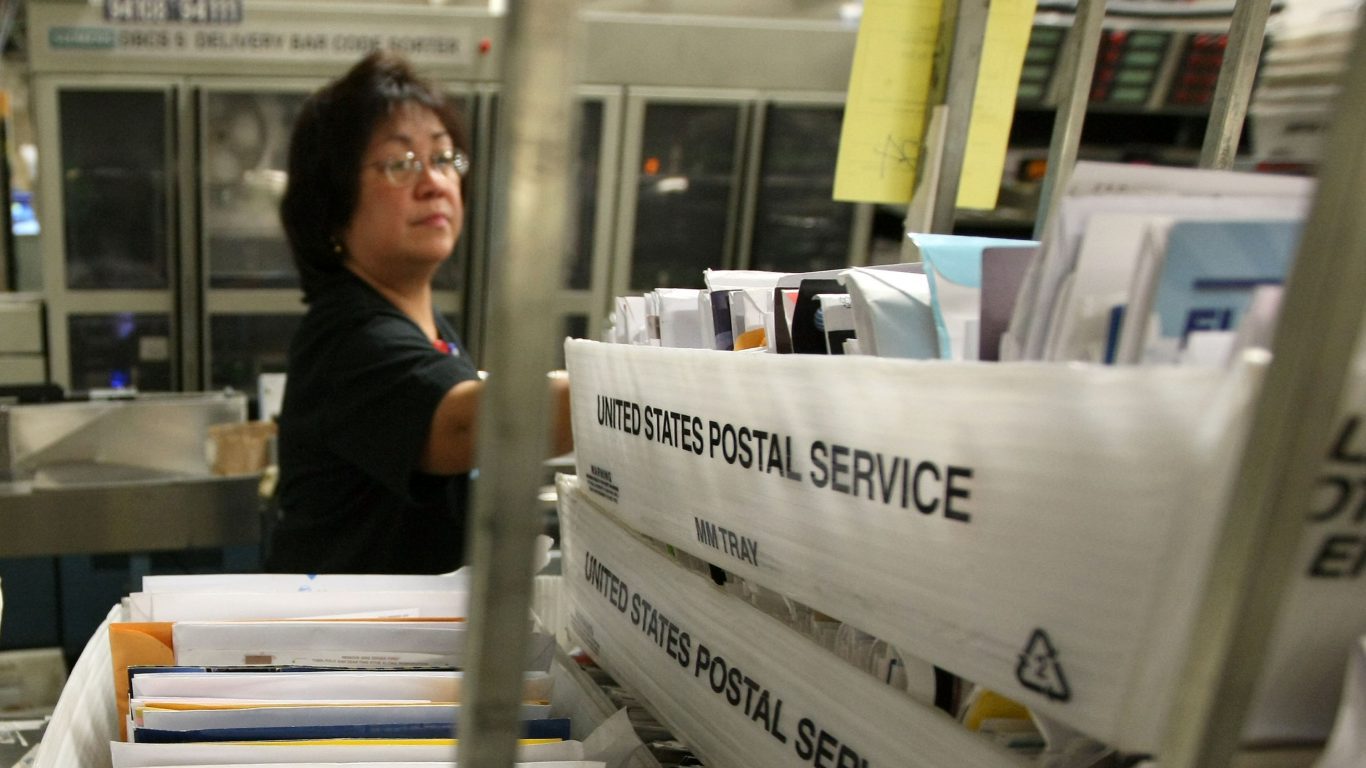Special Report
Jobs Where Most People Are in a Union

Published:
Last Updated:

The U.S. Supreme Court on Feb. 26 heard arguments in the case Janus v. AFSCME. The court will decide whether to prohibit public sector unions from collecting dues for service from non-union employees the union represents.
The eventual ruling could radically reduce the power of collective bargaining in the United States, where the power of unions has steadily eroded for decades. Just over 10% of U.S. workers (about 14.8 million) are union members. As it stands, union membership today is about half what it was in 1983 — the first year data became available.
In light of the Supreme Court case and in honor of Employee Appreciation day on March 2, 24/7 Wall St. reviewed the 19 jobs where more than 50% of workers are union members using data compiled by unionstats.com. The database catalogues data from the Current Population Survey (CPS).
To anyone familiar with organized labor, the list of jobs dominated by unions will likely not come as a surprise. Protective service occupations like firefighting, education jobs like high school teachers, and manual labor-intensive jobs such as millwrights, electricians, and railroad workers continue to have the highest unionization rates.
Unions have always helped improve wages and benefits for workers. Despite the decades-long steady erosion of union power, non-union workers continue to earn just 80% what union members earn on average.
Click here to see the jobs where most people are in unions.
Click here to see our detailed findings and methodology.

19. Electrical and electronics repairers
> Union membership rate: 50.2% (7,446 union members)
> Median annual wage: $59,280
> 2007-2017 change in union membership: +87.0% (3,981 to 7,446)
Employment among the electrical and electronics repairers has remained more or less unchanged over the past decade, falling slightly from 14,963 to 14,844. Union membership, on the other hand, has jumped from 3,981 to 7,446. Membership increased from about one-quarter of the workforce to just over half. Many of these workers are covered by the International Brotherhood of Electrical Workers, or IBEW, one of the largest unions in the world.
[in-text-ad]

18. High school teachers
> Union membership rate: 50.2% (520,871 union members)
> Median annual wage: $58,030
> 2007-2017 change in union membership: -15.8% (618,517 to 520,871)
There are more unionized high school teachers than any occupation where the majority of workers are in unions. However, the percentage of unionized teachers is dwindling. Baby Boomer teachers are more likely to be unionized, and that generation are now retiring en masse. Meanwhile, more charter schools are opening, and teachers at those schools typically do not belong to a union. Overall high school teacher employment dipped 9.1%, from 1,143,329 to 1,038,415. While union members still represent over 50% of high school teachers, their number declined by nearly 16%.

17. Miscellaneous law enforcement workers
> Union membership rate: 50.7% (4,365 union members)
> Median annual wage: $51,730
> 2007-2017 change in union membership: -29.8% (6,214 to 4,365)
Unionized law enforcement jobs have historically offered good pay and excellent benefits. But budgetary pressures have compelled municipalities to reduce these benefits, making the job less attractive even as positions open up due to retirement. The decline of 29.8% in the number union members in the occupation over the 10-year period ending in 2017 is one of the worst among occupations on this list.

16. Pilots and flight engineers
> Union membership rate: 50.8% (65,053 union members)
> Median annual wage: $127,820
> 2007-2017 change in union membership: +4.4% (62,302 to 65,053)
This profession has, by far, the highest median annual wage of any of the 19 jobs on the list. Also, the number of union members in this occupation increased by 4.4% over the past 10 years. Pilots and flight engineers have managed to increase union membership even as the airline industry has consolidated in recent years. The Air Line Pilots Association is the world’s biggest airline pilot union, representing about 60,000 pilots at 34 American and Canadian air carriers.
[in-text-ad-2]

15. Special education teachers
> Union membership rate: 51.0% (218,712 union members)
> Median annual wage: $52,460
> 2007-2017 change in union membership: 0.7% (217,194 to 218,712)
The percentage of union membership among special education teachers has been mostly unchanged in the past 10 years. While there are many openings, the jobs are hard to fill because teachers must be fully certified in special education. The job also comes with extreme paperwork demands that accompany students with special needs. Many of these teachers are municipal employees, and union representation among public employees is much higher than in the private sector.

14. Millwrights
> Union membership rate: 52.9% (21,867 union members)
> Median annual wage: $52,440
> 2007-2017 change in union membership: -39.4% (36,059 to 21,867)
Millwrights install and maintain factory machinery and other production equipment. Total employment in the sector fell from more than 75,000 to less than 42,000 over the past decade. The decline has coincided with an almost 40% drop in unionized workers in this occupational category. However, it appears that unionized positions were less likely to disappear as the trade shrank, as the share of unionized millwrights rose from 47.5% to 52.9% over that period.
[in-text-ad]

13. Iron and steel workers
> Union membership rate: 56.3% (25,955 union members)
> Median annual wage: $51,800
> 2007-2017 change in union membership: -29.5% (36,808 to 25,955)
Iron and steel workers used to be the face of American labor, but the decline of the U.S. steel industry has eroded that image. According to the American Iron and Steel Institute, steel imports rose 19.4% in the first 10 months of 2017. The rise in imports has hurt American steelworkers, who are already dealing with a glut of Chinese steel and other factors cutting into the industry domestically. Employment in the sector is down by over 40 over the last decade, and the number of union workers in the trade has declined by roughly 30%.

12. Police officers
> Union membership rate: 57.8% (413,510 union members)
> Median annual wage: $59,680
> 2007-2017 change in union membership: +7.9% (383,371 to 413,510)
Good pay, very attractive benefits, and a community’s need for protective services helped boost union membership among police officers. Many police officers are represented by the Fraternal Order of Police, the nation’s largest police union. The 7.9% increase in unionized police officers over the past decade, was almost identical to the 7.0% overall increase in police officer employment over the same period.

11. Cementing and gluing machine operators and tenders
> Union membership rate: 59.4% (2,119 union members)
> Median annual wage: $32,290
> 2007-2017 change in union membership: -39.7% (3,516 to 2,119)
Almost 60% of American workers employed as cementing and gluing machine operators are union members. This represents a significant increase, as less than 20% of sector workers were unionized 10 years ago. However, the rise in union membership is likely partly the result of overall employment decline in the sector. The number of workers in the field has fallen by more than 80%, while the number of union workers fell by 40%.
[in-text-ad-2]

10. Rail-track laying and maintenance equipment operators
> Union membership rate: 59.5% (5,692 union members)
> Median annual wage: $53,970
> 2007-2017 change in union membership: -42.9% (9,968 to 5,692)
Union membership among rail-track laying and maintenance equipment operators is plunging faster than overall employment in this occupation. Union membership among rail-track laying and maintenance equipment operators tumbled 42.9%, from 9,968 in 2007 to 5,692 in 2017. Over that time, overall employment slipped 15.8% to 9,564 from 11,360.

9. Reinforcing iron and rebar workers
> Union membership rate: 59.7% (7,670 union members)
> Median annual wage: $47,600
> 2007-2017 change in union membership: +217.6% (2,415 to 7,670)
Union membership among reinforcing iron and rebar workers soared 217.6% over the 10-year period ending in 2017, one of the biggest increases of any occupation. As a result, union members surged to almost 60% of workers in the category. Ten years ago, just 36.9% of workers in the occupation belonged to a union. Over that 10-year timeframe, employment in the occupation climbed 96.3%, from 6,456 to 12,853. The job outlook for this sector seems strong because of the nation’s infrastructure needs.
[in-text-ad]

8. Fire fighters
> Union membership rate: 62.2% (177,219 union members)
> Median annual wage: $48,030
> 2007-2017 change in union membership: -2.3% (181,336 to 177,219)
Many firefighters are municipal employees, and as is the case with law enforcement workers and other occupations with high public-sector employment, the majority of firefighters are unionized. The largest of firefighter unions by far is the International Association of Fire Fighters, which has over 300,000 members across the U.S. and Canada.

7. Elevator installers and repairers
> Union membership rate: 63.1% (24,955 union members)
> Median annual wage: $78,890
> 2007-2017 change in union membership: +45.9% (17,104 to 24,955)
There are just under 40,000 American workers employed in repairing and maintaining elevators, and about 27,000 are union members. These employees work in difficult and dangerous conditions, and the lives of elevator riders rely on their skill. The highly specialized nature of this work may help explain why union representation is so high in the trade. As of 2017, 63.1% of these workers were union members, and 68.2% are covered. One of the largest such unions is the International Union of Elevator Constructors, which has over 25,000 members in the U.S. and Canada.

6. Postal service clerks
> Union membership rate: 64.3% (73,737 union members)
> Median annual wage: $56,790
> 2007-2017 change in union membership: -33.3% (110,568 to 73,737)
No sector of the government has been under greater stress than the U.S. Postal Service, and that is reflected in the ever declining employment in the sector. As private shipping companies like UPS and FedEx have taken business from the U.S. Postal Service, overall employment slid 30.3%, from 164,660 in 2007 to 114,764 in 2017. At the same time, union membership of postal service clerks has plunged by 33.3%, from 110,568 to 73,737. The percentage of union membership has also declined, from 67.1% to 64.3%.
[in-text-ad-2]

5. Postal service mail carriers
> Union membership rate: 68.6% (202,882 union members)
> Median annual wage: $58,110
> 2007-2017 change in union membership: -16.2% (242,051 to 202,882)
Postal service mail carriers are a diminishing breed as well. Overall employment of mail carriers declined 15.1%, from 348,538 in 2007 to 295,635 in 2017. The ranks of the unionized mail carriers slid by 16.2%, from 242,051 to to 202,822. The percentage of the unionized workforce declined from 69.4% to 68.6%, still one of the highest percentages of any occupation.

4. Railroad brake, signal, switch operators, conductors and yardmasters
> Union membership rate: 70.4% (32,746 union members)
> Median annual wage: $56,570
> 2007-2017 change in union membership: -24.0% (43,077 to 32,746)
Fewer people are working on railroads and trains these days as more remote control technology is implemented — which takes away jobs. Overall employment among these workers declined 9.8%, from 51,570 to 46,500 over the past 10 years. Union membership among railroad brake, signal, switch operators, conductors and yardmasters plunged more than 13 percentage points from 83.5%.
[in-text-ad]

3. Train engineers and operators
> Union membership rate: 72.3% (31,895 union members)
> Median annual wage: $57,670
> 2007-2017 change in union membership: -19.2% (39,470 to 31,895)
Workers have more bargaining power if the operation of the business relies on their particular work. If the workers can strike without the business being severely disrupted, they have less bargaining power. Both public and private train services require qualified engineers to operate. Further, replacing a train operator involves taking a risk with a very unforgiving possible outcome, because these train workers hold the safety of potentially hundreds of people in their hands. Many conductors are employees of municipal public transportation systems, and municipal employees are far more likely to be part of a union.

2. Postal service mail sorters, processors, and processing machine operators
> Union membership rate: 73.8% (42,061 union members)
> Median annual wage: $56,220
> 2007-2017 change in union membership: -13.0% (48,367 to 42,061)
As is the case in many heavily unionized professions, the postal service delivery industry has shed jobs in recent years. So although union membership across postal service mail sorters, processors, and processing machine operators declined by 13.0% over the 10-year period ending in 2017, that coincided with the total number of postal service jobs declining by 34%, from 86,385 to 56,994. As a result, the percentage of union members rose more than 17 percentage points to 73.8% of all such workers.

1. Motion picture projectionists
> Union membership rate: 100.0% (2,281 union members)
> Median annual wage: $22,100
> 2007-2017 change in union membership: N/A
Only one occupation in America is completely unionized — and that is motion picture projectionists. Unfortunately for union members in the occupation, their bargaining power is diminished by the fact that they are part of a dying field. Improvements in film technology have largely rendered the occupation obsolete, and total employment fell by 65% in the past decade alone.
Detailed Findings
The jobs listed here are perhaps some of the remaining union strongholds. But while the high membership rates certainly help provide more bargaining power for organizers, many of these unions are operating in struggling industries. In other words, for many reasons that are not entirely understood, heavily unionized sectors are losing ground in the U.S. economy.
Of the 19 jobs where over 50% of workers are unionized, total employment in seven is projected to decline by 2026.
In an interview with 24/7 Wall St., David Macpherson, E.M. Stevens professor and economics department chair at Trinity University, noted the ongoing shift in employment from traditionally union-heavy sectors such as manufacturing to less heavily unionized areas of the economy like services. Many forces are contributing to the decline in unions generally and to this shift in particular:
“[I]ncreased international competition, deregulation of industries like airlines and trucking, [and] increased employer resistance,” are some of the forces Macpherson noted. But the decline may have started earlier, when “they hiked up the union wages in the 1970s, so that accelerated their decline.” In addition, “attitudes towards unions have declined over time,” he said.
Workers in the public sector are far more likely to unionize than those in the private sector, and a significant number of the occupations on this list are public sector jobs. High school teachers, law enforcement workers, firefighters, police officers, postal service workers, and several types of transportation workers are all well represented on this list and tend to be public sector jobs.
According to Macpherson, this is largely because public sector institutions do not have to worry about going out of business. “If you raise wages in the private sector too much, non-union firms are going to undercut you and have you go under,” Macpherson said. “But in the public sector, you can raise wages and just pass those costs on to the taxpayer.”
Methodology
To identify the jobs where most workers are union members, 24/7 Wall St. reviewed the occupations with the highest union membership rates for wage and salaried workers by occupation using data compiled by unionstats.com. The database catalogues data from the Current Population Survey (CPS) using BLS methods. It was constructed by Barry Hirsch of Georgia State University and David Macpherson of Trinity University, and is updated annually. Employment totals and employment projections for each occupations were obtained from the Bureau of Labor Statistics.
Want retirement to come a few years earlier than you’d planned? Or are you ready to retire now, but want an extra set of eyes on your finances?
Now you can speak with up to 3 financial experts in your area for FREE. By simply clicking here you can begin to match with financial professionals who can help you build your plan to retire early. And the best part? The first conversation with them is free.
Click here to match with up to 3 financial pros who would be excited to help you make financial decisions.
Have questions about retirement or personal finance? Email us at [email protected]!
By emailing your questions to 24/7 Wall St., you agree to have them published anonymously on a673b.bigscoots-temp.com.
By submitting your story, you understand and agree that we may use your story, or versions of it, in all media and platforms, including via third parties.
Thank you for reading! Have some feedback for us?
Contact the 24/7 Wall St. editorial team.